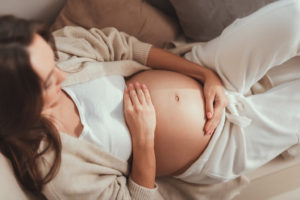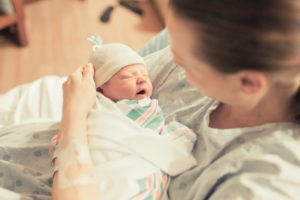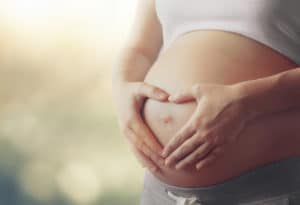A vaginal tear is an injury to the vaginal area that usually bleeds profusely. In contrast, the risk of a vaginal tear is not present during a cesarean section. Basically, a vaginal tear can occur in different segments of the vagina.
Imagine that the vagina is a kind of muscular tube, which is connected to the cervix in the upper part through the cervix. So it is conceivable that the vagina tears in this area. Experts refer to this as a vaginal tear.
Table of contents
The Vaginal Tear During Childbirth
The risk of suffering a vaginal tear is relatively low. Nevertheless, it can never be completely ruled out that a vaginal tear will occur during childbirth. Therefore, many women tend to ask their attending physician about the possible advantages of a cesarean section in this regard.
However, in view of the physical conditions or the health of the child, a cesarean section is often not necessary.The consequences of a vaginal tear include heavy bleeding and severe pain.
However, there are known cases in which the bleeding is rather weak and drains into the body. The problem is that in these circumstances the vaginal tear is often not recognized at first sight.
It happens that the vaginal tear initially remained undetected in the postpartum period. In this case, the damage to the vaginal area often only becomes apparent during subsequent gynecological examinations.
Depending on the type of examination, uterine atony – insufficient contraction of the uterus – is diagnosed instead, or a perineal tear.
Also, in certain situations, doctors suspect placental retention instead of vaginal rupture. This means that the placenta has not completely detached from the placenta.
Experience shows that in many cases it is quite complex to immediately perceive a vaginal tear as such in the postpartum period. There is a real risk that the vaginal tear will be mistaken for the bleeding that regularly accompanies childbirth.
Regardless of whether it is a normal vaginal birth or a suction cup or forceps birth, a vaginal tear can never be 100 percent ruled out in advance.
How The Gynecologist Examines The Vaginal Tear
Generally, a routine examination of the vaginal area is performed after childbirth. During this examination, the woman lies supine on a bed or in a dental chair with her legs spread apart. The physician inserts an elongated, spreadable instrument into the vagina. This instrument is called a speculum.
By spreading the vagina, an examination of the vaginal mucosa is easily possible. This makes it easy to detect a possible vaginal tear. In addition, the physician takes a close look at the perineum. The perineum functions like a kind of skin bridge between the vagina and the anus. Provided there is a vaginal tear, it is sometimes accompanied by a perineal tear.
Notice
Not only the vagina can tear under certain conditions, but also the labia or perineum. In this article, you will learn what a labia tear (labial tear) or a vaginal tear (colporrhexis) means for your health and how you can best prevent the corresponding risks during the birth of your child.
These Factors Can Promote The Risk Of Vaginal Rupture
In a normal vaginal birth, a vaginal tear occurs only in the rarest of cases. Rather, it is possible for the vagina to be damaged during a spontaneous birth. In addition, it can also occur as part of a suction cup or forceps delivery.
The pain associated with a vaginal tear is experienced differently from woman to woman. Some complain of severe pain, while others experience only an unpleasant pulling sensation in the vaginal area.
A so-called labral tear is almost invariably extremely painful. This is because when the labia tear, countless nerve endings are affected. These nerve tracts immediately give a violent pain reflex to the brain, so that the expectant or new mother must immediately receive appropriate pain treatment.
Notice
Should a labia tear occur, it often occurs when the baby’s little head comes out. The tear can then be seen directly in the infant’s nuchal fold.
Doctors then speak of a so-called “blood collar”. For the newborn, the labia tear is not associated with any health consequences.
Other Risk Factors For A Vaginal Tear In The Postpartum Period:
- Use of a suction cup or forceps when the baby is born.
- Deep perineal tear.
- Very low stretching capacity of the vaginal tissue.
- Improperly performed episiotomy or an episiotomy that is too short.
- Fear and internal tension of the expectant mother before and during delivery.
- Too intense pushing during labor.
- Too large a head circumference of the child.
- End of the pelvis or breech presentation.
- Oblique head position of the unborn child.
How You Can Reduce The Risk Of Vaginal Tears
It is normal for expectant mothers to be afraid of a vaginal tear during childbirth. However, it is possible to minimize the possible risk in advance. For example, you can do targeted pelvic floor training before the baby is born.
Ask your midwife for advice and find out how you can best strengthen the muscles of your pelvic floor.
Gynecologists also recommend a daily perineal massage. Perineal massage is particularly useful in the last two to four weeks before the birth. The advantage of perineal massage is that it gradually makes the tissue in the vaginal area more elastic and thus more durable.
Ask your gynecologist or midwife to apply hot, moist compresses to your perineum during labor. The moisture helps relieve tension and dryness in the perineal area. In addition, the combination of moisture and warmth helps immensely with relaxation.
In the case of a cesarean section, the risk of a vaginal tear is naturally non-existent. However, whether a cesarean section is advisable when your child is born is exclusively for the attending physician to determine.
Note
If you want to prevent a vaginal tear by opting for a cesarean section, you should consider the following: A cesarean section is also accompanied by pain. For this reason, you are well-advised to find out whether a C-section is actually preferable to the slight risk of a vaginal tear.
How Is The Vaginal Tear Treated?
If a vaginal tear is present, it is closed by surgical suturing immediately after delivery. In the course of this, the attending physician sutures both sides of the tear with self-dissolving or absorbable sutures.
The woman is given a local anesthetic beforehand. In most cases, the healing process of a vaginal tear after suturing takes only a few days. When the new mother leaves the hospital after the birth of her child, the consequences of the tear are usually hardly noticeable to her.
In the case of a colporrhexis, or a vaginal tear from the uterus, an abdominal opening is essential. A vaginal tear is usually accompanied by extremely severe bleeding and abdominal pain.
It can even have life-threatening consequences for patients. Often, a vaginal tear injures several arteries, so that sometimes even the uterus has to be removed. This is the only way to save the woman from the worst.
The labia tear only needs to be surgically sutured under certain conditions. If the tear is longitudinal, the affected area usually heals on its own. If, on the other hand, the labia tear runs transversely to the tissue skin, surgical intervention is required for correction.
Good To Know
Not every woman gives birth in a hospital. Home births are common, especially in rural areas. If a vaginal tear occurs during a home birth or even during a spontaneous birth, ambulance transport to the nearest hospital must be organized immediately. Until the patient arrives there, she must be placed on her back.
An absorbent compress is placed in the vagina to prevent too much blood from leaking out. For safety’s sake, it is necessary that her legs be positioned crossed at the level of her knees. This is to help put extra back pressure on the vagina to best stop the bleeding.
The consequences Of A Vaginal Tear
In most cases, a vaginal tear heals completely within up to 14 days. However, it is possible that the healing process may be interrupted by any hematomas or bruises. If this is the case, surgical intervention is usually recommended. This is to relieve pressure on the inside of the vagina and help the wound heal.
For some new moms, it is possible that the wound healing process may be disrupted by an infection. A weakened immune system can also contribute to the fact that the sutured vaginal tear does not heal properly at first.
In addition, inferior or unsuitable suture material may also be a factor. In any case, it is important that the wound healing problems are treated quickly and specifically.
This Is What You Can Do To Alleviate The Birth Injury
After a vaginal tear, careful and conscientious care of the intimate area is fundamental. It is important to relieve pressure on the entire vaginal and perineal area. Try to sit on the suture as infrequently as possible.
When breastfeeding, it is best to use a nursing pillow that is shaped like a circle. This way, the abdomen does not come into contact with the surface of the seat.
In any case, avoid sitting on one buttock and do not sit cross-legged. This can stretch the skin in the vaginal area and cause additional irritation.
Change the compression bandages or wraps frequently to prevent the development of germs and bacteria. In addition, make sure the pads are of adequate size and fit comfortably.
Tip
Compression bandages with a plastic coating are welcome to stay on the pharmacy or drugstore shelf. This is because putting them on could create a moisture chamber, which has a negative effect on wound healing. Apart from that, the use of low-quality bandages quickly creates unpleasant odors.
You can cool the injury if you find that pleasant. This usually reduces the pain of the wound at the same time.
Arnica wound wipes have an analgesic, anti-inflammatory and wound-healing effect. It is best to place them on the surface of the bandage so that they come into direct contact with the wound.
Tip
If you have a cesarean section, there is no risk of a vaginal tear. But with a vaginal, forceps, or suction cup birth, increased caution is advised. Generally, a vaginal tear is not associated with any serious health problems.
So you don’t need to worry if you have suffered a birth injury. About a week after the birth of your child, you can start pelvic floor exercises again. This will promote blood circulation and support the healing process.











